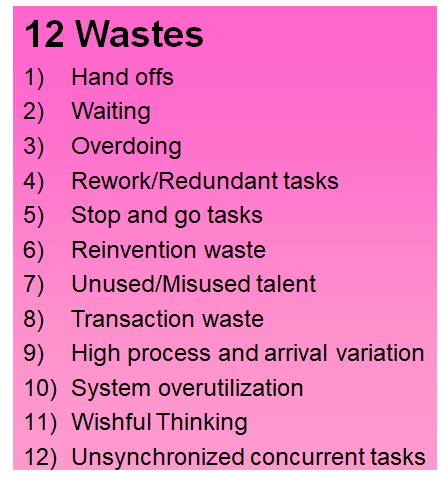Written in collaboration with John Drogosz, PhD and originally published in August 2019 at The Lean Post
The wastes found in manufacturing have been well documented over the years. As we move upstream into product development, the environment is clearly different, but waste is unfortunately just as prevalent. It is harder to “see” as it morphs itself into different categories than those found in the factory. Based on the works of Jim Morgan, Jeff Liker, Allen Ward and our own experiences, below are some wastes commonly seen in product and process development.
1. Handoffs
Transferring information or material from one party to another. While most handoffs in product development are done electronically nowadays, a lot of waste can be generated due to misunderstanding the information being transferred and/or waiting for feedback from others.
2. Waiting
Waiting for data, answers, decisions, review events, and capacity (people or machine). This is one of the most common wastes in product development and can account for more than 30% of the project lead times.
3. Overdoing
Effort and expense expended to generate data that is never used. This is similar to over-processing in the factory. We are creating more and more data but is it really (re)usable knowledge that creates value? Status updates and reports are also areas where we tend to overdo.
4. Rework/Redundant Tasks
Redoing the same work over again – fixing an error, multiple reviews of the same information or multiple approvals. Some iterations using point-based development approaches also lead to a lot of rework and lost time. Not getting cross-functional inputs at the right time can also drive re-design/rework.
5. Stop and Go Tasks
Each time a person has to reorient themselves to a task. It requires multiple “setups” causing additional effort and delays. While giving the illusion that we are progressing, some multitasking can drive stop & go and extend lead times.
6. Reinvention Waste
Re-creating or rediscovering knowledge that we already have and can reuse. This also includes knowledge available outside an organization. “Not invented here” can be a driver of reinvention.
7. Unused/Misused Talent
People working on projects and tasks that customers do not want or need. This is one of the worst wastes as not fully utilizing the talent of our most valuable asset – our skilled people can be demoralizing. Nobody wants to work on a product that a customer does not buy! Remember lean is all about enabling people.
8. Transaction Waste
This is the time and effort arranging for work to be done (e.g., contract negotiations, quotations, resource scheduling, financial reporting). Some of these tasks are nonvalue added but required while others are wasteful distractions from our value-added work.
9. High Process and Arrival Variation
Process variation can be caused by everyone doing tasks in their own way or because they have not been fully trained to a standard process. This typically leads to arrival variation as variable task times lead to uncertain delivery of outputs to downstream customers.
10. System Overutilization
Inserting too much work into a system. Once systems reach approximately 80% utilization, small increases in work dramatically increase lead times of all work in a given system. Large batch releases are large contributors to overutilization as they overburden people and increase cycle times. Overutilization can happen at any level – projects, departments, and individuals’ desks.
11. Waste of Wishful Thinking
As first identified by Allen Ward, widely considered a pioneer in the field of lean product and process development (LPPD), this waste can take several forms. Wishful thinking can be seen in making decisions with inadequate knowledge, setting arbitrary timelines, estimating times to complete tasks, and overly optimistic expectations of learning or discovering new knowledge.
12. Unsynchronized Concurrent Tasks
One of the most insidious wastes. It seems like the right thing to do to work concurrently, but unsynchronized concurrency is often the root cause of a great deal of the other wastes mentioned above. More to come on the Dark Side of Concurrent Engineering in an upcoming post.
Maybe you have seen some of the above waste in your processes? With everyone so busy with all the work that needs to be done on a day-to-day basis, we sometimes simply take the above wastes as just being part of the work. However, the only way to free up your time to create new value is to start seeing and eliminating these wastes. A good way to see and understand the wastes together is through a product development value stream map.


2 responses to “12 Wastes of Product & Process Development”
Great post Katrina, and good to hear from you again! — John Newell
[…] there is plenty of waste in product and service development that should be reduced, the potential benefits are more […]